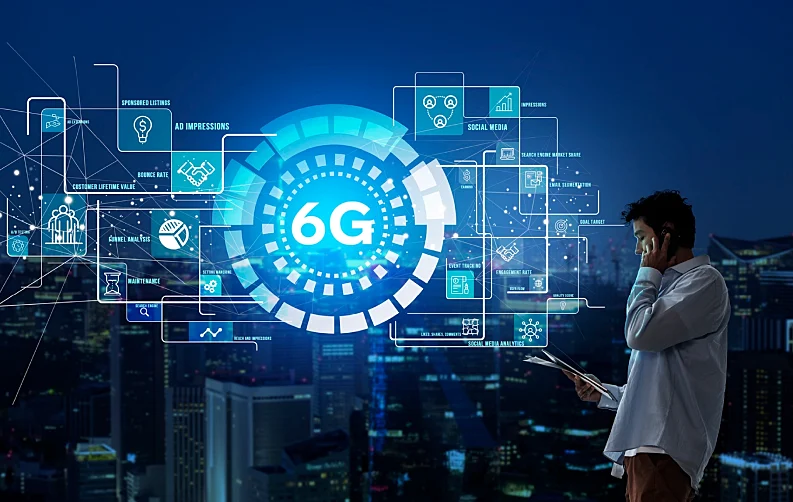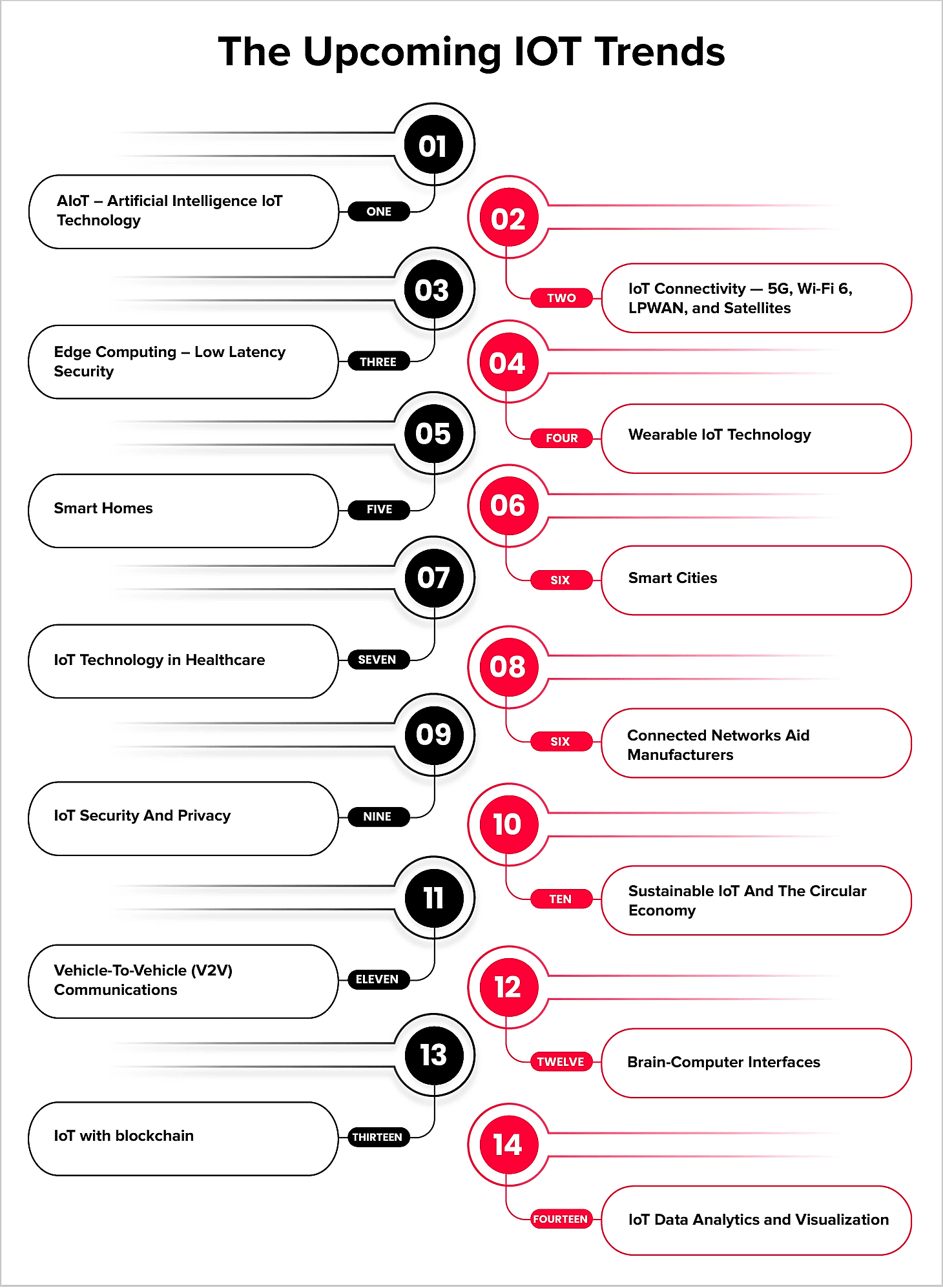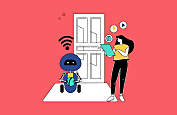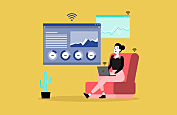
-
What’s Next for IoT Technology in 2024 and Beyond?
- The Upcoming IOT Trends
- AIoT – Artificial Intelligence IoT Technology
- IoT Connectivity — 5G, Wi-Fi 6, LPWAN, and Satellites
- 5G Networks:
- Wi-Fi 6 (802.11ax)
- Low-Power Wide-Area Networks (LPWAN)
- Satellite Connectivity
- Edge Computing – Low Latency Security
- Low Latency Benefits:
- Security Benefits:
- Wearable IoT Technology
- Augmented Reality (AR) Wearables:
- Smart Clothing and E-Textiles:
- Advanced Health Monitoring Wearables
- Smart Homes
- Smart Cities
- IoT Technology in Healthcare
- Connected Networks Aid Manufacturers
- IoT Security And Privacy
- Sustainable IoT And The Circular Economy
- Vehicle-To-Vehicle (V2V) Communications
- Brain-Computer Interfaces
- IoT with blockchain
- IoT Data Analytics and Visualization:
- Conclusion

IoT is rapidly reshaping our world, connecting devices that collect data. There are 13 billion devices worldwide right now. The Internet of Things (IoT) refers to the vast network of interconnected devices that communicate and exchange data with each other over the Internet. From smart home appliances to industrial sensors, IoT devices are designed to collect, share, and use data to improve efficiency, offer new services, and enhance the quality of life.
The IoT industry trends predict that the number will jump to over 30 billion by 2025, showing the impact's significance. IoT has gone beyond a trend, integrating into daily life, revolutionizing industries, streamlining processes, and enhancing experiences.
As technologies evolve and demand grows, IoT is set for big changes by 2024. The merging trends of IoT and AI, along with the rise of 5G and LPWAN, will reshape things. More edge computing and integration of blockchain are also part of this change. These Internet of Things trends will open doors in smart cities, connected healthcare, green manufacturing, and smart transport. We'll look at 10 key IoT trends expected by 2024.
What’s Next for IoT Technology in 2024 and Beyond?
In 2024, the Internet of Things trends will change due to quickly improving technologies and the rising need for easy integration with other advanced technologies such as AI, ML, Blockchain, etc. Here are the top 14 trends in IoT set to form what's ahead:
The Upcoming IOT Trends

The emerging trends in IoT include the integration of AI, Edge computing, 5G networks, and implementing robust security measures to safeguard data integrity and privacy. Let’s explore more new trends in IoT:
AIoT – Artificial Intelligence IoT Technology
AIoT combines artificial intelligence and the Internet of Things, shaping future connected devices. This allows intelligent data analysis from IoT devices using machine learning and natural language processing. AIoT enables predictive maintenance of devices and autonomous decision-making. It is transforming industries by improving efficiency, allowing predictive analytics, and offering customized experiences for users.
The AI in the IoT market is expected to steadily grow its value at an average rate of 6.4% each year. By 2023, the market was worth around $82.1 billion and could surpass $153.1 billion by 2033. These stats show the significant impact of IoT on app development. For example, almost three in four 18-24-year-olds use a phone's voice assistant at home. This shows how widely people accept and rely on AI and IoT together. These trends in IoT show the integration of AI assistants with IoT devices, enabling control of smart appliances and tasks through voice.
IoT Connectivity — 5G, Wi-Fi 6, LPWAN, and Satellites
IoT relies heavily on seamless connectivity and the reliable exchange of data between devices is essential. As IoT spreads more and more, we need quicker, dependable, and far-reaching connectivity solutions. Some Internet of Things latest trends are ready to cater to this expanding demand, open new possibilities, and push IoT innovation's next wave.
5G Networks:
5G networks will enable new IoT applications. With low latency, high bandwidth, and connecting many devices, 5G technology allows real-time data apps that were impossible before. Autonomous vehicles rely on instant data exchange for safe operation, and 5G's low latency enables near real-time communication required for critical decisions.
Similarly, remote healthcare applications like telesurgery demand ultra-reliable connectivity, which 5G can provide. 5G's ability to support hundreds of thousands of devices per square kilometer makes it suitable for densely populated areas with many connected things, such as smart cities or factories.
Wi-Fi 6 (802.11ax)
With its increased efficiency, higher data rates, and better performance in dense settings, Wi-Fi 6 can support the growing number of connected devices in homes, offices, and industry. While 5G addresses wide areas, the latest Wi-Fi generation significantly improves indoor deployments of internet-connected objects.
Low-Power Wide-Area Networks (LPWAN)
5G and Wi-Fi 6 are for high bandwidth and density, while LPWAN is designed for IoT devices needing long range, low power connectivity. Technologies like LoRaWAN, Sigfox, and NB-IoT enable communication over long distances using minimal power, ideal for monitoring, tracking, and smart agriculture.
LoRaWAN uses unlicensed radio bands and a spread spectrum technique for long-range communication using little power. NB-IoT leverages existing LTE networks, providing secure and affordable connectivity for IoT devices.
Satellite Connectivity
Despite advancements in connectivity, satellite connectivity ensures global IoT coverage, bridging gaps in remote/rugged areas with traditional networks.
LEO satellite constellations like Starlink and Project Kuiper aim to provide fast, responsive internet worldwide. They consist of many satellites in lower orbits, allowing improved coverage and latency compared to geostationary satellites.
Satellite connectivity enables precision agriculture, maritime logistics, environmental monitoring, and remote asset management in remote areas. As new satellite constellations launch, satellite-based IoT solutions will likely become more accessible and prevalent.
The connectivity technologies of 5G, Wi-Fi 6, LPWAN, and satellites will create a robust ecosystem to support diverse IoT needs. Each technology offers strengths to ensures reliable, secure efficient data exchange. This unlocks the full potential of the Internet of Things.
Edge Computing – Low Latency Security
IoT devices generate large data and Edge computing helps process and analyze this closer to where it is collected, lowering wait time and improving safety. In traditional cloud-based architectures, IoT devices transmit raw data to centralized cloud servers for processing and analysis. However, this approach can introduce significant latency, particularly for time-sensitive applications that require instant decision-making, such as autonomous vehicles, industrial automation, and remote healthcare monitoring.
The recent trends in IoT in Edge computing bring computation and storage closer to where IoT devices are, enabling critical decisions to be made instantly with minimal data sent to the cloud and latency reduced to mere milliseconds.
Low Latency Benefits:
- Autonomous Vehicles: Split-second decisions are essential for safe operation, and edge computing enables instantaneous processing of sensor data for obstacle detection, navigation, and control.
- Industrial Automation: Real-time monitoring and control of industrial processes through edge computing can minimize downtime and improve efficiency.Healthcare: Edge computing allows immediate analysis of patient data from wearables or remote monitoring, enabling timely interventions and potentially life-saving decisions.
- Traffic management: Intelligent traffic management, public safety monitoring, and emergency response systems benefit from edge computing's low-latency decision-making.
Security Benefits:
- Edge computing keeps sensitive data locally, reducing network transmission. This enhances security by minimizing attack risks from sending data to the cloud.
- Edge devices can leverage advanced security measures like secure enclaves and hardware encryption to protect data and ensure integrity.
- Edge computing enables distributed security architectures across edge nodes, providing a more robust security posture.
Wearable IoT Technology
Wearable devices have gained traction recently, with smartwatches and fitness trackers becoming common. However, by 2024, wearable IoT technology trends are set to advance greatly, driven by size, sensors, and connectivity improvements.
The next generation of wearable IoT devices will expand past basic activity monitoring and alerts, providing diverse functions and programs. These devices seamlessly fit into our daily routines, boosting output, wellness, and general welfare.
Augmented Reality (AR) Wearables:
These devices will provide real-time data, instructions, and context-aware information tailored to the user's environment and activities by overlaying digital information onto the user's field of view. Augmented reality glasses and headsets are anticipated developments in wearable IoT technology.
Smart Clothing and E-Textiles:
These garments are embedded with sensors, electronics, and connectivity, enabling real-time monitoring of various physiological parameters. Smart clothing will find applications in the following areas:
- Sports and Fitness: Tracking metrics, biomechanics, and fatigue to optimize training and prevent injuries.
- Healthcare: Remote monitoring of vital signs, sleep patterns, and medication use for patient care.
- Occupational Safety: Detect potential hazards, monitor worker fatigue, and ensure compliance with safety rules.
- Military and Law Enforcement: Enhancing situational awareness, monitoring health and stress levels, and enabling hands-free communication.
Advanced Health Monitoring Wearables
Advanced health monitoring wearables like continuous glucose monitors, electrocardiogram patches, and sweat sensors will enable remote patient monitoring, early disease detection, and personalized healthcare.
Smart Homes
With voice assistants, homeowners can control lights, temperature, entertainment, and appliances using their voice or a schedule. Devices connect to create smart living environments based on patterns and preferences.
These systems use advanced sensors, cameras, and connectivity to detect threats, unauthorized entry, or unusual activity. They can automatically alert homeowners or authorities if needed. Integration with smart locks, lighting, and cameras creates a comprehensive security solution.
Smart thermostats, lighting controls, and appliances optimize energy use by adjusting settings based on occupancy, schedules, and usage. Some systems integrate with solar panels, enabling homeowners to monitor energy production and consumption more efficiently. As smart home tech matures, devices will seamlessly communicate to create personalized, intelligent living spaces.
Smart Cities
Cities worldwide use IoT to make infrastructure smarter, services better, and sustainability a priority. A top use is smart traffic systems, collecting real-time data from sensors, cameras, and connected cars. They change light times, divert routes, and lessen jams.
These intelligent lighting systems can automatically adjust their brightness based on traffic and weather, saving energy and improving safety. IoT sensor networks can track air quality, noise levels, water quality, and other environmental factors. This provides data to inform sustainable policies and initiatives.
In many smart city projects, integrated platforms combine data from IoT systems, enabling efficient resource use, predictive upkeep, and enhanced citizen involvement. These platforms often include mobile or IoT app development platforms and dashboards allowing residents to access real-time info, report issues, and participate in decision processes.
IoT Technology in Healthcare
Remote patient monitoring through wearable devices and sensors allows continuous tracking of vitals, medications, and activity. This real-time data lets providers intervene quickly, adjust treatments, and possibly prevent hospital stays.
Telemedicine using IoT and video calls has led to virtual visits, remote diagnosis, and monitoring treatment. IoT trends in healthcare greatly improve health protection access, especially in underserved or remote areas, while reducing burdens on facilities and using resources efficiently.
Within facilities, connected IoT device trends such as pumps, ventilators, and imaging sharing seamlessly, enabling coordination and reducing risk. This interconnectivity of IoT in healthcare facilitates remote monitoring and maintenance of critical, ensuring optimal performance and minimizing downtime.
IoT tracking and monitoring in healthcare supply chains prevents counterfeits, ensures proper storage, and optimizes inventory. This saves costs and enhances safety by guaranteeing authenticity and quality of medical and pharmaceutical supplies. As healthcare embraces IoT, we'll see advancements in personalized care, predictive tools, and data-guided choices, leading to better patient results and more efficient systems.
Connected Networks Aid Manufacturers
Smart sensors in manufacturing continuously monitor equipment, detect issues, and trigger automatic fixes. This minimizes breakdowns and costly repairs. IoT trends in manufacturing have brought intelligent, connected factories and production lines for the first time.
Collaborative robotics and automated guided vehicles (AGVs) work seamlessly alongside human operators, increasing productivity while ensuring worker safety. These connected systems can adapt to changing production requirements, optimize workflows, and respond to real-time demand fluctuations.
Supply chain visibility and inventory management are improved with IoT tracking of materials, work, and goods. This real-time view lets managers optimize resources just in time. Data from connected factories also helps analytics find patterns and processes to improve and drive continuous changes.
IoT connectivity has revolutionized asset management and maintenance in factories. Connected machines self-report metrics, enabling predictive maintenance and minimizing downtime. This proactive approach extends asset lifespan, enhances efficiency, and reduces maintenance costs.
IoT Security And Privacy
As the IoT security trends expand into various aspects of our lives, ensuring security and protecting privacy have become top concerns. Addressing these challenges requires approaches across secure design, advanced encryption and authentication, and evolving regulations.
IoT devices are safer by integrating encryption, authentication, access control, and regular updates. Blockchain can enable secure device identity, data provenance tracking, and secure data sharing within IoT in mobile app development. This enhances transparency and trust and makes it more difficult for malicious actors to compromise the system.
Regulatory frameworks, industry standards, governments, and organizations are working to address IoT's security and privacy challenges. They aim to establish guidelines and best practices for secure IoT deployments, data handling, and consumer protection, including how to use VPN-secure IoT devices for additional security.
Sustainable IoT And The Circular Economy
IoT can optimize resource usage, reduce waste, and minimize environmental impact. IoT-enabled sensors and tracking systems can monitor waste levels, optimize collection routes, and identify opportunities for recycling and reuse, reducing greenhouse gas emissions and promoting a circular economy.
IoT-powered building systems can adjust heating, cooling, and lighting based on occupancy, weather, and energy usage. This smart energy management reduces owners' consumption and costs while helping the environment.
IoT sensors, drones, and weather data help farmers optimize crop yields, minimize water and pesticide use, and farm sustainably. Precision irrigation systems deliver water and nutrients straight to plant roots, reducing waste and runoff. As sustainability grows critical, pairing IoT with renewable sources like solar and wind will enable decentralized, smart green energy systems.
Vehicle-To-Vehicle (V2V) Communications
Autonomous vehicles can now talk to each other, sharing important information like speed and location. This helps connected vehicles exchange operational details easily.
Vehicles can communicate hazards, coordinate actions, and adjust speeds and trajectories, reducing collisions and improving traffic flow. AI and autonomous vehicles can identify hazards and coordinate braking and steering by talking to each other. This helps lower risks and improves traffic flow.
ADAS and cooperative features like platooning rely on V2V data exchange. Platooning has vehicles follow closely, using V2V to keep safe distances and move together. This enhances safety while improving fuel efficiency by reducing drag.
V2V communication promises intelligent transportation and smart cities. Sharing real-time traffic data between connected vehicles can help coordinate traffic lights, alleviate congestion, reduce emissions, and optimize urban traffic flow.
Brain-Computer Interfaces
While still developing, BCIs allow thought control of devices. Brain activity communicates directly with computers, enabling interaction through neural signals alone. BCIs show promise in assistive technologies. By interpreting brain signals, BCIs can enable those with physical disabilities to control prosthetics, wheelchairs, and other devices. This significantly improves independence and quality of life.
BCIs are explored for healthcare uses like stroke recovery, Parkinson's treatment, and helping spinal cord injuries. They provide a direct brain link, allowing focused help for the nervous system.
BCIs hold potential in gaming and entertainment, enabling immersive control of virtual environments and characters through thought. This could revolutionize interaction with digital content and open new avenues for creative expression.
IoT with blockchain
Blockchain and IoT integration aims to boost security, transparency, and trust in connected systems. Blockchain allows IoT devices to record data in a decentralized ledger securely. It gives devices secure identities and authenticates data origins. This let's devices securely share data without a central authority.
Blockchain and IoT can enable end-to-end traceability in supply chains, verifying authenticity and origins. This builds trust with consumers and fights counterfeits. It also supports sustainable and ethical sourcing.
Decentralized energy trading platforms use blockchain and IoT. They help people trade energy directly and use renewable sources for sustainability.
IoT Data Analytics and Visualization:
As discussed above, IoT devices generate large amounts of data. Advanced analytics and visualization tools extract useful information and data-driven choices.
IoT data analytics uses techniques like statistics, machine learning, and AI to process and study huge amounts of information from devices. These methods find secret patterns, connections, and developments. They allow prediction analysis, anomaly discovery, and process improvement.
Predictive analytics softwares can use historical and real-time IoT data to forecast equipment failures, demand, and risks. This enables proactive maintenance, preemptive actions, and efficient resource use.
Data visualization is key for understanding complex data from IoT, like trends and issues. Dashboards visualize key metrics, patterns, and outliers in real-time, helping stakeholders spot needs quickly.
Data visualization techniques like augmented and virtual reality transform how we interact with IoT data. These technologies provide new views and understandings by overlaying visuals onto the physical world or making virtual environments. This enhances decision-making and collaboration.
Conclusion
There’s no denying to the fact the IoT value will surge by 2030! The trends and implications of IoT have transformed many fields and will continue to change our lives. Smart cities, healthcare, manufacturing, and transportation have benefitted from IoT. As this technology grows, security, privacy, and sustainability must be priorities. By adopting innovation responsibly, more efficiency, experiences and IoT connections are possible.

Sr. Content Strategist
Meet Manish Chandra Srivastava, the Strategic Content Architect & Marketing Guru who turns brands into legends. Armed with a Masters in Mass Communication (2015-17), Manish has dazzled giants like Collegedunia, Embibe, and Archies. His work is spotlighted on Hackernoon, Gamasutra, and Elearning Industry.
Beyond the writer’s block, Manish is often found distracted by movies, video games, AI, and other such nerdy stuff. But the point remains, If you need your brand to shine, Manish is who you need.












